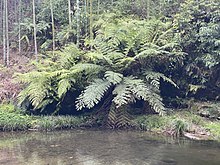
Back Boomvaring Afrikaans كياثونية Arabic كياثونيه ARZ Cyatheaceae Byelorussian Ciateàcies Catalan Cyatheaceae CEB Cyateovité Czech Træbregne-familien Danish Cyatheaceae German Ciateacoj Esperanto
| Cyatheaceae Temporal range:
| |
|---|---|

| |
| Cyathea glauca | |
| Scientific classification | |
| Kingdom: | Plantae |
| Clade: | Tracheophytes |
| Division: | Polypodiophyta |
| Class: | Polypodiopsida |
| Order: | Cyatheales |
| Family: | Cyatheaceae Kaulf. |
| Genera | |
| Synonyms | |
| |
The Cyatheaceae are a family of ferns, the scaly tree ferns, one of eight families in the order Cyatheales in the Pteridophyte Phylogeny Group classification of 2016 (PPG I).[1] Alternatively, the family may defined much more broadly (Cyatheaceae sensu lato) as the only family in the Cyatheales, with the PPG I family treated as the subfamily Cyatheoideae.[2] The narrower circumscription is used in this article.
The family includes the world's tallest tree ferns, which reach heights up to 20 m. They are also very ancient plants, appearing in the fossil record in the late Jurassic, though the modern genera likely appeared in the Cenozoic. Cyatheaceae are the largest family of tree ferns, including about 640 species.[1] Cyatheaceae and Dicksoniaceae, together with Metaxyaceae and Cibotiaceae, do not form a strongly supported monophyletic group and could be paraphyletic, but several individual subgroups are well supported as being monophyletic. Cyatheaceae are leptosporangiate ferns, the most familiar group of monilophytes.[3]
The Cyatheaceae usually have a single, erect or creeping rhizome (stem). Their fronds (leaves) are also very large, although not as large as the tree ferns of the Marattiaceae. Some species have fronds reaching 3–4 m in length, and have a final crown width of some 6 m. The fronds are circinate before unfolding and usually pinnately or bipinnately compound, with deeply pinnately lobed leaflets. The large leaves are covered in scales and hairs, and bear sori (spore clusters) on their undersides.[4] The sori are often covered by a flap of tissue called an indusium, a useful characteristic for classifying the Cyatheaceae. Some indusia are cup-shaped (cyatheoid), while others are hood-shaped (hemitelioid), enclose the sorus (sphaeropteroid), or scaly. Like most ferns, members of the Cyatheaceae are homosporous. Cyatheaceae are found in both New and Old World tropical wet montane forests and cloud forests, with some species extending into south-temperate regions.[3] Most Cyatheaceae are terrestrial, with one being a facultative epiphyte and others having a creeping habit.

Cyatheaceae can be distinguished from arborescent Dicksonia by the presence of scales, the position of the sori, and the morphology of sporangia and spores.[5] In the Cyatheaceae, the sori occur away from the margins of the pinnules, and are elongate or rounded.
- ^ a b Cite error: The named reference
PPGIwas invoked but never defined (see the help page). - ^ Cite error: The named reference
ChriChas14was invoked but never defined (see the help page). - ^ a b Cite error: The named reference
KoraConaMetzSchn07was invoked but never defined (see the help page). - ^ Judd, W.S., C.S. Campbell, E.A. Kellogg, P.F. Stevens, and M.J. Donoghue (Eds.) 2008. Plant Systematics: A Phylogenetic Approach, Third Edition. Sinauer Associates, Sunderland, Massachusetts, USA.
- ^ Holttum, R.E. and P.J. Edwards. 1983. The tree-ferns of Mount Roraima and neighbouring areas of the Guayana highlands with comments on the family Cyatheaceae. Kew Bulletin 38(2): 155-188.
© MMXXIII Rich X Search. We shall prevail. All rights reserved. Rich X Search